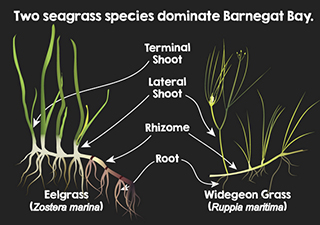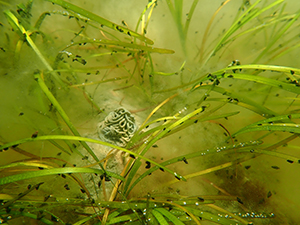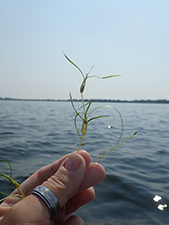Fact Sheet FS1349
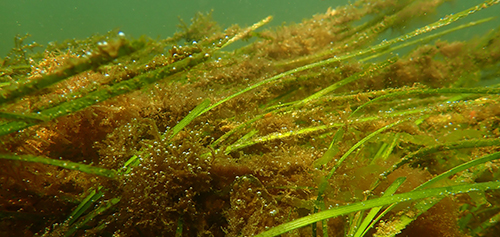
Figure 1. Eelgrass in Barnegat Bay, New Jersey surrounded by seaweed creating gas bubbles during photosynthesis. Photo credit: E. Lacey, 2019.
Marine plants play an important role in our coastal marine ecosystems, yet they are widely misidentified and underappreciated despite their great ecological and economic value. The objectives of this fact sheet are to educate the general public and those working in coastal communities about the basic differences between seagrass and seaweed, the importance of seagrass and seaweed in marine ecosystems, and to raise awareness on the threats to seagrasses that cause their significant declines both globally and locally in New Jersey. An improved understanding will also help better prepare individuals on the steps necessary to mitigate these threats in order to become seagrass advocates and encourage responsible stewardship of our marine resources and ecosystems.
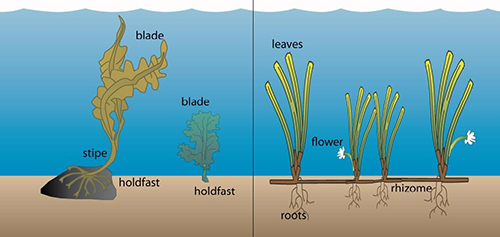
Figure 2. Seaweed (nonvascular) (left) and seagrass (vascular) (right) plant comparison. Graphic credit: Integration and Application Network (ian.umces.edu), University of Maryland Center for Environmental Science.
What Are Marine Plants?
The category of 'marine plants,' particularly those submerged underwater, encompasses two main types that are vastly different: seagrasses and seaweeds (Figure 1). Generally speaking, seagrasses are vascular plants, which grow similarly to the grass on your lawn, while seaweeds are nonvascular, and take advantage of any extra nutrients to grow exponentially (Figure 2).
Vascular plants, like seagrasses, have what is considered a true root, stem, and leaf structure and function. Photosynthesis in these marine plants occurs only in the leaves of the plant and nutrient uptake occurs only in the roots. Nonvascular plants, like seaweeds, do not have such specific structures but instead absorb nutrients throughout their entire body via a process called diffusion, or the passive movement across a membrane. This is an important distinction because nonvascular plants,
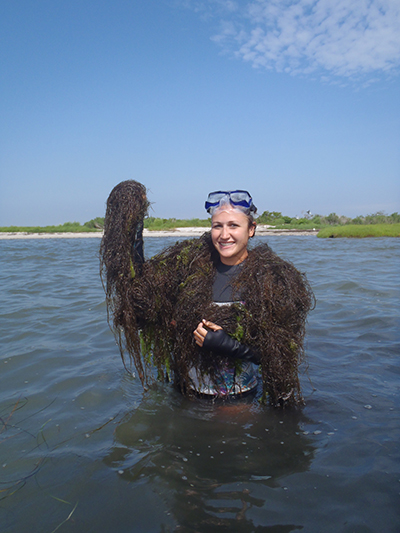
Figure 3. Student researcher in Barnegat Bay, New Jersey gathers armfuls of seaweed, which are considered a type of macroalgal bloom that can be seen with the naked eye. Microalgal blooms (not shown) can be visible as water discoloration but must be viewed under a microscope. Photo credit: E. Lacey, 2019.
like seaweed, can take up nutrients more quickly than vascular plants, like seagrasses (Dawes 1998, Larkum, et al., 2006). This expedited nutrient uptake is what can lead to large macroalgae blooms, which commonly occur in estuaries, including in New Jersey (Figure 3).
Large seaweed blooms can also be influenced by the way marine plants reproduce. Reproduction in marine vascular plants occurs in a similar fashion to terrestrial plants, through the production of fruits, flowers, and seed structures. Pollination in seagrasses occurs through water movement rather than wind or insects. Reproduction in marine nonvascular plants is much simpler and is by spores dispersed in the water column with no pollination necessary. Both vascular and nonvascular marine plants are capable of asexual and sexual reproduction, and are dependent on sunlight to photosynthesize in order to grow and reproduce.
There is a distinct difference between large seaweeds (also called 'macroalgae') and smaller algae ('microalgae') also called phytoplankton. Macroalgae refers to those plants visible to the naked eye, and which typically grow attached to rocks or other hard substrate until reaching a size or mass in which they can break off and freely drift. Microalgae refers to single-celled phytoplankton that drift within the water column and are invisible to the naked eye. Microalgae can exist independently or group together to form colonies. Both macro- and microalgae can experience blooms, with microalgae blooms often referred to as 'brown tide,' which is an example of a harmful algal bloom.
Figure 4. Basic differences between eelgrass and widgeon grass (a). Eelgrass has much wider leaves and is not branched (b), while widgeon grass collected in Barnegat Bay, New Jersey is thinner and branched (c). Graphic credit: Squidtoons.com. Photo credit: E. Lacey, 2021.
Seagrass species in New Jersey can most easily be identified when thought of in terms similar to the grass on a typical lawn. There are clear, parallel veins in the strap-like leaves of the most common seagrass, Zostera marina or "Eelgrass." There are also very distinct root structures just below the soil surface. The other most common seagrass species, Ruppia maritima or "Widgeon grass," has a branched growth habit, and thinner leaves and roots than Eelgrass (Figure 4). The smaller Widgeon grass leaves still have veins, though not as clearly seen as on Eelgrass. Widgeon grass is more tolerant of freshwater and higher water temperatures, conditions in which Eelgrass becomes stressed and when leaf loss or shedding occurs. Widgeon grass only occurs in the northern portions of Barnegat Bay while Eelgrass occurs throughout Barnegat Bay and Little Egg Harbor Estuary. Both seagrass species have chlorophyll, which gives them their distinct green coloration. Seaweed species may resemble grasses, including having a green coloration, but none have the venation or distinct root structure (Figure 5). Instead of roots, many macroalgae have a structure called a holdfast, which secures them to rocks, rubble, and shell. There are a wide variety of body shapes, including those that are sheet-like, highly branched and bushy, finger-like and spongy, or even leathery with air bladders.
Ecosystem Services
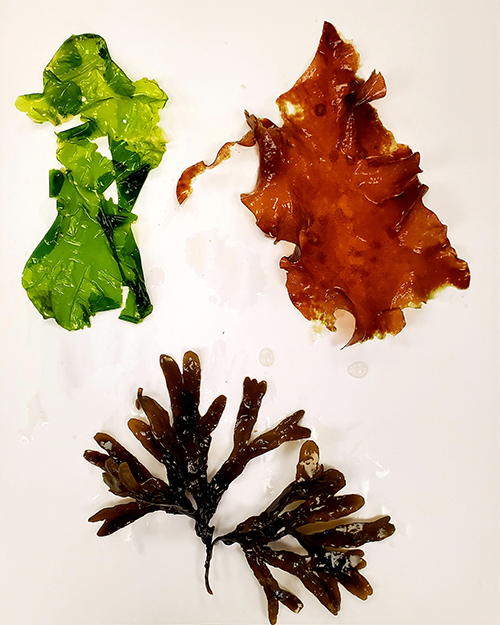
Figure 5. Common seaweed species in Barnegat Bay, New Jersey. Sea lettuce (green), nori (red), and rockweed (brown). Photo credit: E. Lacey, 2021.
Ecosystem services provided by marine plants are limited with seaweeds but numerous with seagrasses. Marine seaweeds in New Jersey do provide food and habitat for some organisms but currently have limited ecological or economic impact. The most important ecosystem service that seaweeds perform is as drift seaweed, when it provides a mobile corridor for juvenile fish and invertebrates to move between larger habitats, like seagrass meadows and oyster reefs. Seagrass meadows, on the other hand, provide many important ecosystem services around the world and here in New Jersey, including habitat, shoreline stabilization, and climate mitigation.
Seagrasses serve as essential habitat for the majority of species caught in nearshore commercial and recreational fisheries in New Jersey, whether it be during larval, juvenile, or adult life stages. Seagrass serves as places for refuge, attachment, reproduction, or feeding (Havel, 2018). For example, summer flounder larvae produced during offshore spawning events enter estuaries in late fall and early winter when seagrass meadows serve as critical habitat for much of their first year of life. Adult summer flounder complete an annual inshore-offshore migration pattern, residing in New Jersey's estuaries during warmer months, using seagrass meadows for feeding and refuge habitats, and then migrate offshore in the fall for spawning. Many other finfish use seagrass meadows during different life stages, such as winter flounder, bluefish, and striped bass. For all fishes, the quality of the habitat is important as healthy seagrass meadows provide the essential foundation for productive populations and sustainable fisheries.
Healthy seagrass meadows also provide important services for commercially and recreationally important invertebrate species like blue crabs and bay scallops. For example, in the Chesapeake Bay, research has shown that the density, diversity, and cover of seagrass positively influenced juvenile blue crab density. Additionally, bay scallops, which were once far more abundant in New Jersey's estuaries, are very reliant on seagrass habitats, from juveniles that attach to seagrass leaves to adults who benefit from increased feeding opportunities and reduced predation within a seagrass meadow. Therefore, seagrasses provide essential ecosystem services for many species of great value to New Jersey's commercial and recreational fisheries by serving as essential habitat and supporting the overall survival and productivity of many species. In turn, these ecosystem services and enhanced productivity provide economic benefits for harvest by commercial and recreational fishermen.
In addition to the role of seagrass as critical habitat, seagrass meadows play an important role in shoreline stabilization as they dampen wave energy and retain soils that would otherwise erode and wash away. Preventing erosion also protects property and shorelines from the detrimental impacts of strong wave action and extreme conditions experienced during storms and hurricanes. Additionally, seagrass meadows remove carbon from the atmosphere (thought to be approximately 10 percent of the carbon stored in the entire ocean) and reduce coastal acidification, which can harm important shellfish and finfish species. Ultimately, this means that efforts to protect and restore seagrasses can also help to reduce the effects of climate change and save both life and property. To that end, ecosystem services provided by seagrass meadows have been valued at more than $26.9 billion per year in Barnegat Bay alone (Kauffman & Cruz-Ortiz, 2012). In order to further realize the economic benefits of shoreline protection and ecological benefits of habitat building, seagrasses can be utilized as plantings during the development of living shorelines, which are comprised of a mix of habitats such as wetlands, oyster reefs, and seagrass meadows in an effort to more closely mimic natural conditions.
Global Threats and Conservation Challenges for Seagrasses
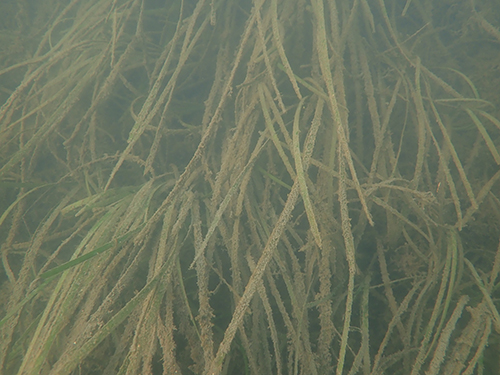
Figure 6. Eelgrass meadow in Barnegat Bay, New Jersey in a high turbid environment with seagrass leaves smothered in sediment and algal growth. Photo credit: E. Lacey, 2019.
Seagrass meadows are threatened globally by declines in water quality, direct habitat destruction, and fisheries interactions. These photosynthetic vascular plants have high light requirements for support of their structures during growth and reproduction. Therefore, seagrasses experience severe impacts when the amount of light available to them is reduced. For example, excess nutrients entering a marine environment often lead to blooms of phytoplankton, which reduce water clarity and decrease how much light can reach the seafloor where seagrasses grow. In addition, microalgae and macroalgae can form a coating on seagrass leaves called epiphytes, further reducing available light (Figure 6). Light can also be reduced through soils that enter the water during storm events and storm water runoff, which have been occurring with greater frequency and severity as influenced by climate change. Further changes in water quality can occur through climatic change-induced sea level rise, with less light available for plant growth as water depth increases, and increasing sea temperatures, which shifts coastal water bodies away from optimal growing temperatures for seagrasses.
In addition to declines in water quality, direct habitat destruction can occur via boat groundings and construction projects. Considering that seagrass must grow in shallow enough waters to access light, this puts them in the direct path of motorized vessels. Prop scars and blow outs from grounded vessels attempting to maneuver off seagrass meadows cause damage that can take decades to heal. These scour marks are frequently at deeper depths than the adjacent seagrass meadows and, with frequent resuspension activities, can further cloud the water and make it difficult for light to penetrate. Light penetration is also reduced during construction projects that fill dredge holes or construct bridges. Construction activities stir up soils into the water column, which not only reduce the available light but can also bury adjacent seagrass meadows. Depending on the construction activities, there may also be deposit of construction materials or structures on seagrass meadows, from which it is nearly impossible for seagrasses to recover.
Lastly, seagrass meadows can be threatened by fisheries interactions. While seagrass meadows play a significantly positive role in supporting fisheries productivity around the world (Nordlund et al., 2018; Unsworth et al., 2018), fishing activities have often had negative impacts on seagrasses (Atlantic States Marine Fisheries Commission, 2000). One of the largest impacts is the mechanical damage that can occur to seagrasses when mobile fishing gear, such as dredges or bottom trawls, are towed through seagrass meadows. Static fishing gear such as traps can also result in damage to seagrasses from repeated settings or dragging of the gear while hauling or setting. For the shellfish aquaculture industry, floating cages and bottom racks can directly block the light available for plant growth while harvest practices can disturb the soils in which seagrasses need to grow. Adoption of responsible fishing practices and appropriately designed fisheries management policies can reduce these negative interactions that have already caused substantial damage to this critical habitat.
Less direct than the physical damage caused by fisheries gear, alterations in food webs can negatively impact seagrass meadow ecosystems. Trophic cascades, or the ecological changes influenced by the addition or removal of top predators through overharvesting (Atwood and Hammill, 2018), impact seagrass health when algal grazers (such as blue crabs, snails, and tiny crustaceans) are removed from the system. These algal grazers keep the seagrass leaves clean from algal growth, providing a greater surface area for sunlight and photosynthesis (van Montfrans, 1984, Hughes et al., 2004).
Restoration or mitigation from these losses is difficult due to the lack of site-specific data on many important seagrass growing requirements and the high variability between regions. There is a need for more detailed information on the effects of water quality, water movement, and soil conditions on seagrass. The method of restoration that is selected depends on these important site characteristics for the feasibility and success of using adult plants, seedlings, and seeds, or methods involving clusters of shoots, compostable bags of seeds, and plugs of adult plants, for instance. Filling this data gap remains an issue in some regions as there is a disconnect as seagrass meadows are not directly consumed in contrast to other resources considered more valuable in coastal communities. There also remain educational challenges in properly identifying seagrasses (a habitat of great ecosystem service) versus seaweeds (frequently considered a nuisance species).
Status and Trends of New Jersey Seagrass
Seagrass meadows in New Jersey have been in decline since at least the 1960s and have not shown an increase in coverage since that time. Unfortunately, no recent data on acreage of seagrass meadows exist to adequately account for any significant changes, given that the most recent seagrass survey was limited in scope and conducted in 2009. Regarding their distribution, more than 75% of the seagrass meadows of New Jersey exist in Barnegat Bay, but recent estimates calculate their coverage at roughly 14% of the bay bottom. Data are also limited on the health of the seagrass meadows and whether they are still providing the same level of ecosystem services as previously reported, although more recent work through the Barnegat Bay Partnership is seeking to evaluate these responses (Lacey 2016, 2018, 2020, 2022). In some regions of Barnegat Bay, the seagrass meadows are experiencing a shift from Widgeon grass to Eelgrass, but the impacts of this shift on the environment are unknown as the ecosystem services provided by each seagrass differs. While mitigation or restoration of seagrasses may be an important next step, there is a lack of research on the methods that hold the greatest potential. Given currently proposed and anticipated projects within the Barnegat Bay, destruction of additional seagrass meadows may be imminent, and the concern remains about how best to mitigate the potential losses as well as preserve current meadows.
Additional Resources
Acknowledgements
Thank you to the students of Stockton University and Rutgers Cooperative Extension’s Coastal Stewardship course for their interest and questions on seagrasses. Their frequently asked questions were considered in the development of this fact sheet.
References
October 2022
Copyright © 2024 Rutgers, The State University of New Jersey. All rights reserved.
For more information: njaes.rutgers.edu.
Cooperating Agencies: Rutgers, The State University of New Jersey, U.S. Department of Agriculture, and Boards of County Commissioners. Rutgers Cooperative Extension, a unit of the Rutgers New Jersey Agricultural Experiment Station, is an equal opportunity program provider and employer.


